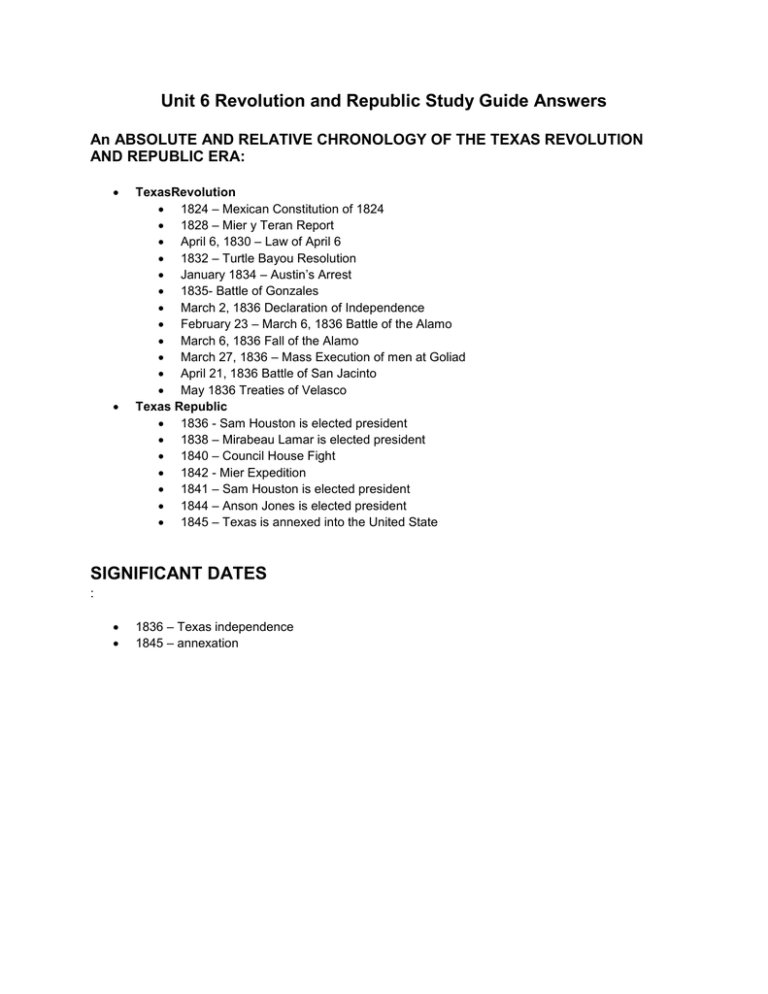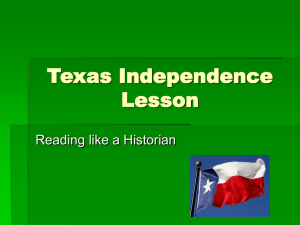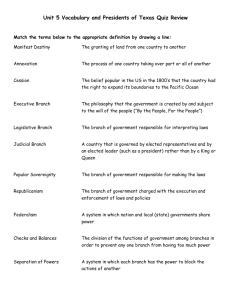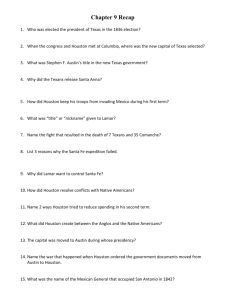Unit 6 Study Guide Answers
advertisement

Unit 6 Revolution and Republic Study Guide Answers An ABSOLUTE AND RELATIVE CHRONOLOGY OF THE TEXAS REVOLUTION AND REPUBLIC ERA: TexasRevolution 1824 – Mexican Constitution of 1824 1828 – Mier y Teran Report April 6, 1830 – Law of April 6 1832 – Turtle Bayou Resolution January 1834 – Austin’s Arrest 1835- Battle of Gonzales March 2, 1836 Declaration of Independence February 23 – March 6, 1836 Battle of the Alamo March 6, 1836 Fall of the Alamo March 27, 1836 – Mass Execution of men at Goliad April 21, 1836 Battle of San Jacinto May 1836 Treaties of Velasco Texas Republic 1836 - Sam Houston is elected president 1838 – Mirabeau Lamar is elected president 1840 – Council House Fight 1842 - Mier Expedition 1841 – Sam Houston is elected president 1844 – Anson Jones is elected president 1845 – Texas is annexed into the United State SIGNIFICANT DATES : 1836 – Texas independence 1845 – annexation EVENTS THAT LED TO THE TEXAS REVOLUTION: Fredonian Rebellion – in 1826, in Nacogdoches, a group of Texans formed the Fredonian Republic led by the Edwards Brothers, claimed the area was no longer under Mexican control. Stephen F. Austin sided with the Mexican government and marched to Nacogdoches to help stop the rebellion. It ended quickly. Mier y Terán – in 1828, the Mexican government sent Gen. Manuel Mier y Terán to investigate the conditions in northern Texas. He found that the Anglo-Americans outnumbered Mexicans 10 to 1. The report resulted in the Law of April 6. Law of April 6, 1830 – in 1828, the Mexican government sent Mier y Terán to report on the new immigrants moving into Texas. He reported concerns about the Anglo Americans. This resulted in the Law of April 6 which outlawed immigration from the U.S. to Texas and canceled all empresarial grants that had not been fulfilled. It did encourage European immigration. Enslaved people could no longer be brought into Mexico to work, and customs duties were imposed on all goods entering Texas from the U.S. Turtle Bayou Resolutions – Anahuac settlers gathered at Turtle Bayou following the uprising at Anahuac. John Austin was sent to retrieve a cannon to be brought back from Brazoria and drafted resolutions pledging continued loyalty to Mexico under the Constitution of 1824. Santa Anna seemed to support the Constitution of 1824. This event resulted in Colonel Jose de las Piedras ordering the release of William B. Travis and Patrick Jack from jail. Bradburn was dismissed from his command with the Mexican army Arrest of Stephen F. Austin – Austin travels to Mexico to meet with Mexican officials and delivers the resolution written by Texas officials about their concerns. When he gets there, Santa Anna has become the leader of Mexico, but so much time has gone by that Austin sends a letter back to Texas to tell Texas officials to establish a state government. He gets a meeting with Santa Anna that agrees to many of the grievances and returns to Texas. On his return, he is arrested for treason because of the letter he wrote to Texas officials earlier. He is not allowed to return to Texas until summer of 1835. ROLES PLAYED BY SIGNIFICANT INDIVIDUALS DURING THE TEXAS REVOLUTION George Childress – chaired the committee in charge of writing the Texas Declaration of Independence Lorenzo de Zavala – helped write the Texas Declaration of Independence and helped design the ad interim government at Washington-on-the Brazos; was elected Vice President of the new republic James Fannin – led the Texans at Coleto Creek and surrendered to Urrea; later he was executed at Goliad by order of Santa Anna Sam Houston – leader of the Revolutionary Army during the Texas Revolution Antonio López de Santa Anna – dictator of Mexico, and military leader of the Mexican Army during the Texas Revolution Juan Seguín – served with Travis at the Alamo, but survived because he was sent out as a messenger to warn Sam Houston about the events at the Alamo. He continued to serve under Sam Houston at the Battle of San Jacinto. William B. Travis –military leader of the Texas forces at the Alamo; was killed by Mexican forces at the Alamo ISSUES SURROUNDING SIGNIFICANT EVENTS OF THE TEXAS REVOLUTION Battle of Gonzales o First battle of the Texas Revolution – October 2, 1835 o Citizens of Gonzales would not give up a cannon that was given to them by the Mexican government to protect them from American Indians. o A militia led by J.H. Moore flew a flag over the cannon which said “Come and Take It”. o Lieutenant Francisco Castaneda led 100 men to Gonzales to take the cannon. o The militia fired the cannon on October 2 at the Mexican soldiers, a battle began, and so did the Texas Revolution. William B. Travis's letter "To the People of Texas and All Americans in the World" o Travis wrote this letter to recruit men to help him and his men at the Alamo after Santa Anna showed up in San Antonio, February 23. The siege of the Alamo and all the heroic defenders who gave their lives there o Sam Houston ordered the Alamo to be destroyed. o James Bowie and James Neill decided that the Alamo was too important. o James Bowie and William Travis began to recruit supporters. o Santa Anna arrived in San Antonio. o The Texans moved into the Alamo and for 13 days fought the Mexicans. o The fall of the Alamo occurred on the morning of March 6, 1836. o 1800 Mexican troops fought against approximately 189 Texans. o All Texans were killed, and approximately 600 Mexican soldiers were also killed. Constitutional Convention of 1836 o Texas delegates met at Washington-on-the-Brazos. o Declared independence from Mexico on March 2, 1836 o Wrote a constitution to form an ad interim government for the Republic of Texas Fannin's surrender at Goliad o Colonel James Fannin surrendered his 300 men at the Battle of Coleto because he was pinned on the open prairie. o Texans fought the Mexicans off, but Fannin decided to surrender to prevent more deaths. o Captives were marched to Goliad, and Urrea told them they were not going to be killed, but Santa Anna ordered the captives to all be shot on March 21. Battle of San Jacinto o April 21, 1836 o Shortest battle in history o Sam Houston led the Texas forces – 800 men o Santa Anna led the Mexican forces – 1300 men o Houston burned every way out of San Jacinto and attacked the Mexican Army about 3:00 p.m. o The battle lasted 18 minutes o Santa Anna was captured the next day and surrendered to Sam Houston HOW THE ESTABLISHMENT OF THE REPUBLIC OF TEXAS BROUGHT CIVIL, POLITICAL, AND RELIGIOUS FREEDOM TO TEXAS The establishment of the Republic of Texas was based on the freedoms most Texans had when they lived in the United States. This meant that they would not live under a dictatorship (political), and their civil liberties (civil/religious) like speech, religion, press, and assembly would be protected under a constitution. Slavery was allowed under the Texas Constitution. INDIVIDUALS, EVENTS, AND ISSUES DURING THE ADMINISTRATIONS OF REPUBLIC OF TEXAS PRESIDENTS HOUSTON, LAMAR, AND JONES President Sam Houston First Administration (1836-1838) – Houston focused on forming a government, and dealing with the issues of debt, the army, conflict with American Indians and Mexico, and selecting a capital. Texas Rangers – when Sam Houston became President, he dismissed the army because of its cost and leadership. He replaced them by reinstating the Texas Rangers. He used them to fight the attacks by the American Indians and the Mexican soldiers that crossed the border. Chief Bowles – he was the leader of a group of Cherokees that arrived in Texas in 1820. He signed a treaty with Sam Houston during the Texas Revolution. Third Administration (1841-1844) – according to the Constitution, a person couldn’t be elected two times in a row. Most Texans were unhappy with the conflict during Lamar’s administration and re-elected Houston. His main focus was to return peace, decrease the public debt, and prepare Texas for statehood. Texas Rangers/Mier Expedition (1842) o Due to the Santa Fe Expedition, Mexico began to invade Texas. o Houston sent Texas Rangers to guard the border, and the threat was over. o 300 Texans remained and crossed into Mexico to Mier. o A battle enraged for two days, and the Texans surrendered. o Texans were marched to Mexico City and executed by Santa Anna (again the ruler of Mexico) by the captured drawing a black bean. President Mirabeau Lamar (1838-1841) – did not agree with Houston’s policies. During his administration, he focused on pushing American Indians farther west, a commitment to education, and a new capital (Austin). On the negative side, he more than doubled the public debt by way of Indian Wars and increased inflation. Texas Navy o During Houston’s administration, the Navy protected the Texas coast, but it was a drain on the nation’s finances. o Lamar had Congress issue bonds to purchased ships. o Ships were used to conduct unsuccessful secret peace negotiations between Texas and Mexico, blockading the Mexican coast, and an invasion of Mexico. o Most Navy officers were recruited from the U.S. Navy. o Very costly, and most uses not successful o Commodore of Navy – Edwin Moore o Houston tried to sell the Navy during his second term, but it fell through. o When Texas was annexed, the Texas Navy was taken over by the U.S. Navy. INDIVIDUALS, EVENTS, AND ISSUES DURING THE ADMINISTRATIONS OF REPUBLIC OF TEXAS PRESIDENTS HOUSTON, LAMAR, AND JONES Edwin W. Moore o Commodore of the Texas Navy o 28 years old, fluent in both English and Spanish, had a dozen years of naval experience o Aided Yucatan rebels by blockading the Mexican coast o Dishonorably discharged by Houston and court-martialed for supporting the Yucatan rebels José Antonio Navarro o Served as Bexar’s (San Antonio) representative in the Texas Congress o He tried to protect Tejano land claims and other rights; he was a voice of Tejanos. o Supporter of Mirabeau B. Lamar and a critic of Sam Houston o Chosen as one of President Lamar's commissioners to accompany the Texan Santa Fe expedition o Delegate to the Convention of 1845, which decided annexation, and he helped write the state constitution o Served in the Texas Senate Cordova Rebellion / the role of racial and ethnic groups (American Indians and Tejanos) o After the Texas Revolution, there was an influx of Americans to Nacogdoches, where the population was primarily Mexican. o Some Mexicans living in Nacogdoches remained loyal to Mexico. One loyalist was Vicente Cordova. o Vicente Cordova, along with American Indians who were loyal to Mexico, began to organize with almost 400 people along the Angelina River. o Before anything happened, the group was defeated. o The impact was a distrust of Mexicans and Native American and Lamar’s decision that Cherokees would need to be removed from Texas. Council House Fight o Lamar’s administration o March 19, 1840 – a group of Comanche leaders agreed to meet in San Antonio to surrender all Anglo captives. o One captive – Matilda Lockhart was delivered. o Texans were angry, and refused to let the Comanches leave. o The Comanches tried to leave and were attacked. o Led to the death of seven Texans and many Comanche leaders who were unarmed and outnumbered. o To this date, the Comanche nation refuses to make peace with the Texas Rangers over this event. Santa Fe Expedition o Lamar’s Administration o June 1841 – Lamar sent troops to claim the western boundary of Texas, all the land east of the Rio Grande, which included Santa Fe, and a part of present-day New Mexico. o Mexico did not agree, and neither did the citizens of Santa Fe. o By the time the Texans got there, they were in short supply and exhausted. o Texans were captured and marched to Mexico City, and then thrown into prison. o The expedition was a failure and cost a great sum of money. o Mexicans began raiding Texas again. INDIVIDUALS, EVENTS, AND ISSUES DURING THE ADMINISTRATIONS OF REPUBLIC OF TEXAS PRESIDENTS HOUSTON, LAMAR, AND JONES Chief Bowles o During the Lamar administration (1839), Chief Bowles was ordered to lead the Cherokees out of Texas. Bowles refused. Lamar ordered the militia to drive them out by force. Bowles was killed, and the Cherokees were forced to present-day Oklahoma. Texas Rangers o Lamar used the Texas Rangers to fight the Mexicans and American Indians. Jack Coffee Hays o One of the best-known Texas Rangers. A surveyor of the Republic of Texas and a captain of a Texas Ranger company. President Anson Jones (1844-1845) o Jones supported Houston’s policies. He maintained peace with the American Indian tribes, tried to limit spending, and turned over Texas to the United States. Republic of Texas o Mary Maverick – she and her husband, Samuel, established a large ranch near the San Antonio area. She recorded her daily life in diaries and journals between the days of the Republic of Texas and the Civil War. Maverick worked hard making sure the history of Texas was preserved. o William Goyens – a free African-American who was a well-to-do businessman. He was a blacksmith, wagon manufacturer, freight hauler, mill owner, landowner, and farmer in Nacogdoches. He was of mixed race and spoke Spanish and several native Texan languages. Goyens was an important negotiator for Texas with the Cherokees. o Enslaved people – the status of African Americans changed dramatically during the Republic of Texas. Slavery was legalized, and freed enslaved people in Texas had to get an act of Congress to remain freed in Texas. EFFECTS OF PHYSICAL AND HUMAN FACTORS ON MAJOR EVENTS IN TEXAS Texas Revolution o o The fall and spring brought heavy rains and cold fronts that made it very difficult to travel, especially across rivers (e.g., Brazos and Trinity). The Runaway Scrape and the path to the San Jacinto battleground was made very difficult because of heavy rains and cold fronts. Landforms Battle of Coleto Fannin stopped in an open prairie to give his men a rest, but the Mexicans were able to surround them. Fannin’s men had no natural resources to protect themselves, resulting in a defeat. HOW THE TEXAS CONSTITUTION REFLECTS THE PRINCIPLES OF LIMITED GOVERNMENT State of Texas Constitution of 1836 o Republicanism – a belief that government should be based on the consent of the people; people exercise their power by voting for political representatives Article I. SEC.3 The members of the House of Representatives shall be chosen annually, on the first Monday of September each year, until Congress shall otherwise provide by law, and shall hold their offices one year from the date of their election. Limited Government – the principle that requires all U.S. citizens, including government leaders, to obey the law Article I. SEC. 12. Judgment in cases of impeachment shall only extend to removal from office, and disqualification to hold any office of honor, trust or profit under this Government; but the party shall nevertheless be liable to indictment, trial, judgment and punishment according to law. (Article 15 explains the impeachment process which puts limits on what officeholders can and cannot do while they hold office.) Checks and Balances – the ability of each branch of government to exercise checks, or controls, over the other branches Article I. SEC. 6. The House of Representatives shall choose their speaker and other officers, and shall have the sole power of impeachmentbeing charged with misconduct during office. Federalism – a system of government where power is shared between the central (or federal) government and the state governments Separation of Powers – the division of basic government roles into branches Article I. SEC. 1. The powers of this Government shall be divided into three departments, viz: Legislative, Executive and Judicial, which shall remain forever separate and distinct. Popular Sovereignty – a government in which the people rule; a system in which the residents vote to decide an issue General Provisions SEC. 1. Laws shall be made to exclude from office, from the right of suffrage, and from serving on juries, those who shall hereafter be convicted of bribery, perjury, or other high crimes and misdemeanors. Individual Rights – a personal liberty and privilege guaranteed to U.S. citizens by the Bill of Rights Declaration of Rights First. All men, when they form a social compact, have equal rights, and no man or set of men are entitled to exclusive public privileges or emoluments from the community







